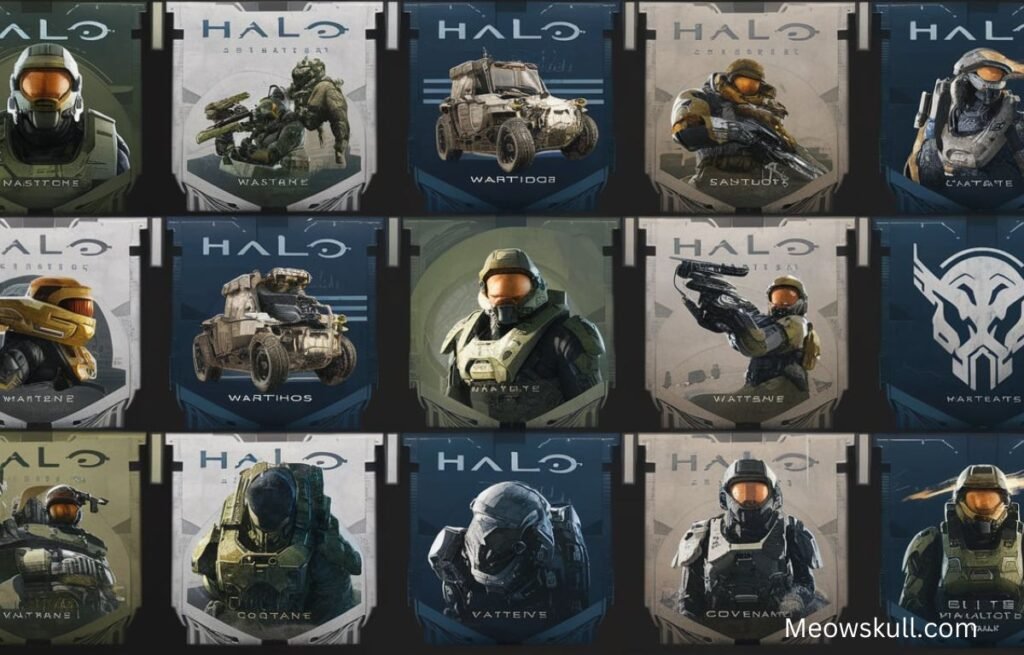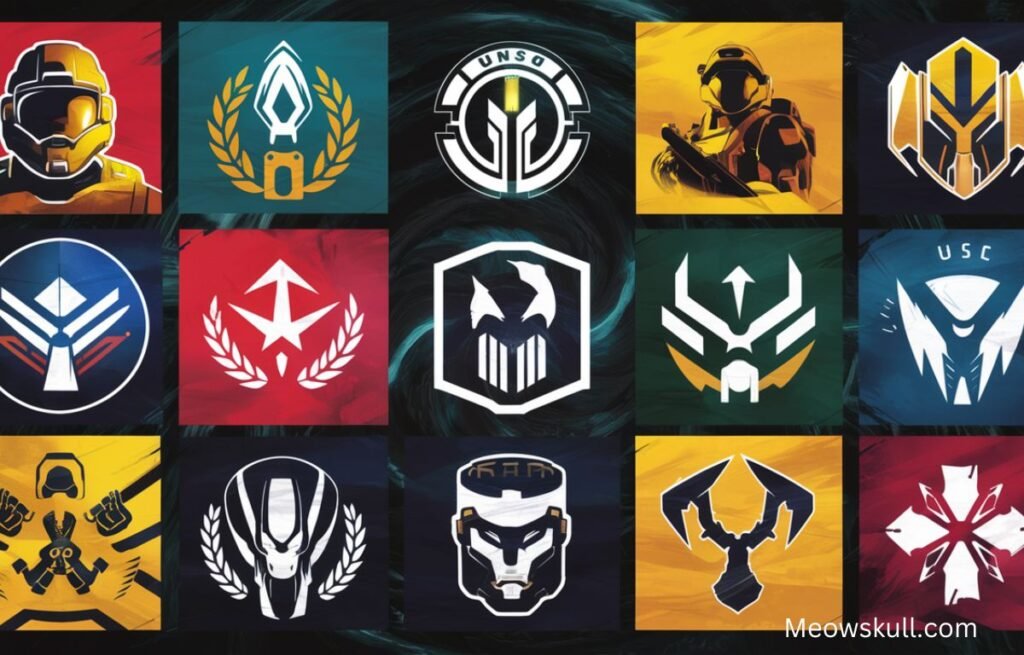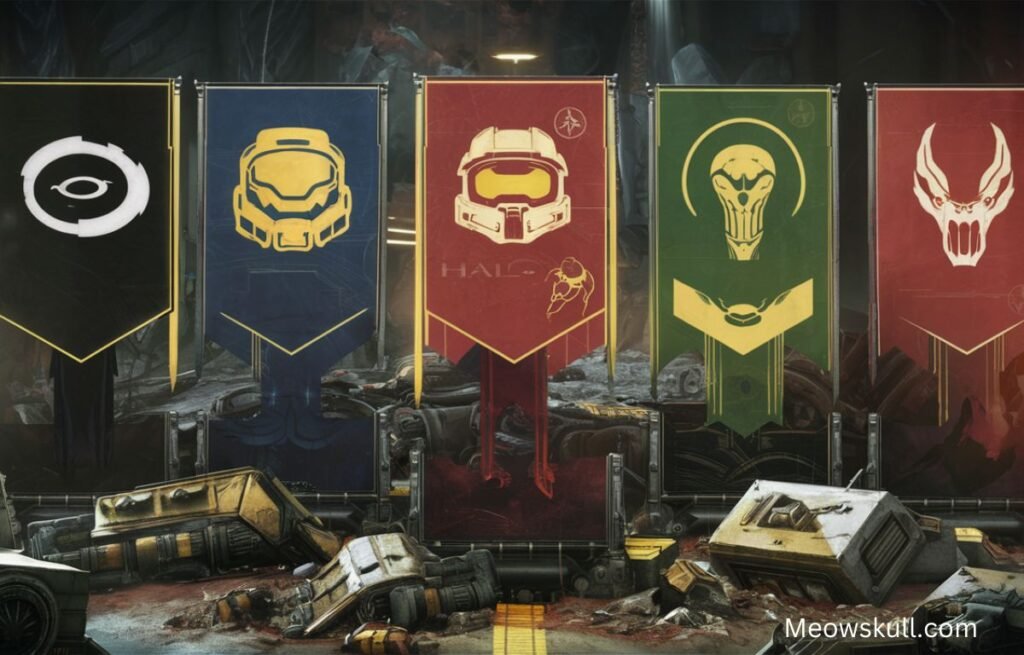The year 2003 was pivotal in the world of gaming. It marked the rise of “Halo,” a game that didn’t just set the bar but redefined what gamers expected from first-person shooters. With its thrilling gameplay, captivating storyline, and iconic multiplayer mode, “Halo (2003)” became more than just a game—it became a cultural phenomenon. But beyond the gameplay, one of the most memorable aspects of “Halo” was its icons and banners. These visual elements became symbols of the game and played a significant role in its branding and recognition.
The Role of Icons in “Halo (2003)”
Icons in “Halo (2003)” were more than just decorative elements; they were a language. From the famed Spartan helmet to the energy sword, each icon represented something crucial in the game. These icons helped players quickly identify weapons, enemies, and objectives, making gameplay smoother and more intuitive.
The Spartan Helmet: A Symbol of Master Chief
One of the most iconic images from “Halo (2003)” is the Spartan helmet. This symbol is instantly recognizable to anyone familiar with the series. The helmet, which belongs to the game’s protagonist, Master Chief, represents strength, resilience, and heroism. It’s not just an icon; it’s a badge of honor for players who have spent countless hours battling the Covenant.
The Energy Sword: A Mark of Power
Another unforgettable icon is the energy sword. This weapon, used by the Covenant’s Elite, became a fan favorite for its sleek design and powerful attack. The energy sword icon is synonymous with swift, lethal action and has remained a beloved symbol in the Halo series.
The Impact of Banners in “Halo (2003)”

While icons provided quick in-game information, banners served a different purpose. They were the game’s way of communicating its theme, tone, and story to players. These visual elements were prominently displayed in menus, loading screens, and promotional material, making them a crucial part of the game’s identity.
The Main Menu Banner: Setting the Tone
When players first launched “Halo (2003),” they were greeted by a banner that set the stage for the entire experience. The main menu banner featured the Halo ring, floating in space, surrounded by a mysterious and ominous atmosphere. This image perfectly captured the game’s mix of sci-fi wonder and impending danger, drawing players into its world even before they started playing.
Multiplayer Banners: Building the Hype
Multiplayer was a huge part of “Halo (2003),” and the banners used in this mode were designed to heighten the excitement. Images of intense battles, with Spartans facing off against each other, were common in multiplayer banners. These visuals not only showcased the action but also fostered a sense of competition and camaraderie among players.
Also Read: The Art of Saying “I Look Forward to Meeting You”
The Evolution of Icons and Banners in Halo
The icons and banners from “Halo (2003)” laid the groundwork for what would become a staple in the Halo series. As the franchise evolved, so did its visual elements. However, the foundation built by the 2003 game remained strong.
Halo 2 and 3: Building on the Legacy
In the sequels, Halo 2 and Halo 3, the icons and banners became more sophisticated but still retained the essence of the original. The Spartan helmet and energy sword continued to be central symbols, while new icons and banners were introduced to represent the evolving story and gameplay.
Modern Halo Games: A Nod to the Past
Even in the more recent Halo games, like Halo 4 and Halo Infinite, there’s a clear connection to the visuals of the 2003 game. While the graphics have improved, and the designs have become more complex, the core symbols have remained. This continuity helps maintain a sense of nostalgia for long-time fans while still appealing to new players.
The Cultural Impact of “Halo (2003)” Icons and Banners

The icons and banners from “Halo (2003)” didn’t just stay within the confines of the game—they transcended it. These visual elements became part of popular culture, appearing in fan art, merchandise, and even tattoos. They became symbols of a shared experience among gamers, representing not just the game itself but the community that grew around it.
Merchandise and Memorabilia
One of the ways these icons and banners have endured is through merchandise. From t-shirts to posters, the symbols from “Halo (2003)” have been emblazoned on countless items. Fans proudly display the Spartan helmet or the energy sword, showing their love for the game and its world.
Fan Art and Creations
The creativity of the Halo community has kept the game’s icons and banners alive and well. Artists from around the world have reinterpreted these symbols in their own unique styles, creating everything from digital art to sculptures. This fan-driven content has helped keep the legacy of “Halo (2003)” alive, even as the gaming landscape continues to evolve.
Also Read: The Power of Raven Team Leadership: A Quick Guide
How “Halo (2003)” Set a Standard for Game Branding

The success of “Halo (2003)” can be attributed to many factors, but its branding played a crucial role. The game’s icons and banners were not just visually appealing—they were memorable and effective. They communicated the game’s essence quickly and clearly, making them a powerful tool for both gameplay and marketing.
The Importance of Visual Consistency
One of the reasons the icons and banners from “Halo (2003)” were so effective is their consistency. The game’s visual language was strong and cohesive, making it easy for players to associate certain symbols with specific meanings. This consistency also helped with branding, as the same icons and banners appeared in promotional materials, on websites, and in the game itself.
Influence on Other Games
The success of Halo’s visual branding didn’t go unnoticed. Many other games have since adopted similar strategies, using icons and banners as key elements in their own branding. Whether it’s a specific weapon icon or a memorable banner, the influence of “Halo (2003)” can be seen in countless other titles.
Conclusion: The Enduring Legacy of “Halo (2003)” Icons and Banners
The icons and banners from “Halo (2003)” are more than just images—they are a legacy. They represent a time when gaming was evolving, and they played a crucial role in defining the identity of one of the most iconic games in history. Even today, over two decades later, these visual elements continue to resonate with players, old and new alike.
As the gaming world continues to evolve, the influence of “Halo (2003)” remains strong. Its icons and banners have set a standard for game branding, showing how powerful visual elements can be in creating a lasting impact. Whether you’re a long-time fan or a newcomer, the legacy of these symbols is undeniable—they are a testament to the enduring power of great game design.
Also Read: Meowskulls Explosive Return meowskull.com
FAQs
What is the significance of the Spartan helmet icon in “Halo (2003)”?
The Spartan helmet icon in “Halo (2003)” is one of the most recognizable symbols in the game. It represents the game’s protagonist, Master Chief, and has become a symbol of strength, resilience, and heroism. This icon is more than just a visual element; it’s a representation of the character’s legendary status within the gaming community.
How did the energy sword icon become so popular?
The energy sword icon became popular due to its sleek design and powerful in-game performance. It symbolizes swift and lethal action, making it a favorite among players. The energy sword’s iconic status was solidified through its frequent use in gameplay and its association with the formidable Covenant Elites.
Why were banners important in “Halo (2003)”?
Banners in “Halo (2003)” were crucial for setting the tone and theme of the game. They were used in menus, loading screens, and promotional materials to communicate the game’s atmosphere and story. These visual elements helped to immerse players in the world of Halo even before they began playing.
How did the main menu banner contribute to the game’s atmosphere?
The main menu banner in “Halo (2003)” featured the Halo ring in space, surrounded by a mysterious and ominous atmosphere. This image set the tone for the entire game, capturing the mix of sci-fi wonder and impending danger that defined the Halo experience. It was a powerful visual that drew players into the game’s world from the very beginning.
How have icons and banners from “Halo (2003)” influenced modern Halo games?
The icons and banners from “Halo (2003)” have had a lasting influence on the entire Halo franchise. While newer games have introduced more complex and sophisticated visuals, the core symbols—like the Spartan helmet and energy sword—have remained consistent. This continuity helps maintain a sense of nostalgia for long-time fans while still appealing to new players.
How have “Halo (2003)” icons and banners impacted popular culture?
The icons and banners from “Halo (2003)” have transcended the game itself, becoming part of popular culture. These symbols appear in fan art, merchandise, and even tattoos. They represent a shared experience among gamers and have become lasting symbols of the game’s legacy.
Why is visual consistency important in game branding?
Visual consistency is crucial in game branding because it helps create a strong and cohesive identity. In “Halo (2003),” the consistent use of icons and banners made it easy for players to associate specific symbols with certain meanings. This consistency also helped with branding, ensuring that the game’s identity was clear across all platforms, from in-game elements to promotional materials.
How did “Halo (2003)” set a standard for other games in terms of branding?
“Halo (2003)” set a high standard for game branding through its effective use of icons and banners. These visual elements were not only memorable but also communicated the essence of the game quickly and clearly. Many other games have since adopted similar strategies, recognizing the power of strong visual branding in creating a lasting impact.
What role did multiplayer banners play in “Halo (2003)”?
Multiplayer banners in “Halo (2003)” were designed to heighten the excitement and competition among players. These banners often featured images of intense battles between Spartans, showcasing the action and fostering a sense of camaraderie within the gaming community. They were a key element in building the hype for the game’s multiplayer mode.
How has the fan community kept the legacy of “Halo (2003)” icons and banners alive?
The Halo fan community has played a significant role in keeping the legacy of “Halo (2003)” icons and banners alive. Through fan art, merchandise, and creative reinterpretations, these symbols continue to resonate with players. The community’s dedication to preserving and celebrating these visual elements has helped ensure that the legacy of “Halo (2003)” endures.

As a seasoned contributor to “Meowskull”, Rosalie combines her linguistic prowess with a keen understanding of various topics, ensuring a delightful and informative reading experience. Her articles effortlessly blend clarity, creativity, and a touch of elegance, making language exploration an exciting journey for readers.